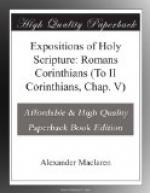But, once more, the body unredeemed has appetites and desires which may lead to their own satisfaction, which do lead to sordid cares and weary toil. ’The flesh lusts against the spirit and the spirit against the flesh.’ The redeemed body will have in it nothing to tempt and nothing to clog, but will be a helper to the spirit and a source of strength. Glorious work of God as the body is, it has its weaknesses, its limitations, and its tendencies to evil. We must not be tempted into brooding over unanswered questions as to ’How do the dead rise, and with what body do they come?’ But we can lift our eyes to the mountain-top where Jesus went up to pray. ’And as He prayed the fashion of His countenance was altered, and His raiment became white and dazzling’; and He was capable of entering into the Shekinah cloud and holding fellowship therein with the Father, who attested His Sonship and bade us listen to His voice. And we can look to Olivet and follow the ascending Jesus as He lets His benediction drop on the upturned faces of His friends, until He again passes into the Shekinah cloud, and leaving the world, goes to the Father. And from both His momentary transfiguration and His permanent Ascension we can draw the certain assurance that ’He shall fashion anew the body of our humiliation, that it may be conformed to the body of His glory, according to the working whereby He is able even to subdue all things unto Himself.’
III. The redeemed body is a consequence of Christ’s indwelling Spirit.
It is no natural result of death or resurrection, but is the outcome of the process begun on earth, by which, ’through faith and the righteousness of faith,’ the spirit is life. The context distinctly enforces this view by its double use of ‘adoption,’ which in one aspect has already been received, and is manifested by the fact that ‘now are we the sons of God,’ and in another aspect is still ‘waited’ for. The Christian man in his regenerated spirit has been born again; the Christian man still waits for the completion of that sonship in a time when the regenerated spirit will no longer dwell in the clay cottage of ‘this tabernacle,’ but will inhabit a congruous dwelling in ‘the building of God not made with hands, eternal in the heavens.’
Scripture is too healthy and comprehensive to be contented with a merely spiritual regeneration, and is withal too spiritual to be satisfied with a merely material heaven. It gives full place to both elements, and yet decisively puts all belonging to the latter second. It lays down the laws that for a complete humanity there must be body as well as spirit; that there must be a correspondence between the two, and as is the spirit so must the body be, and further, that the process must begin at the centre and work outwards, so that the spirit must first be transformed, and then the body must be participant of the transformation.




